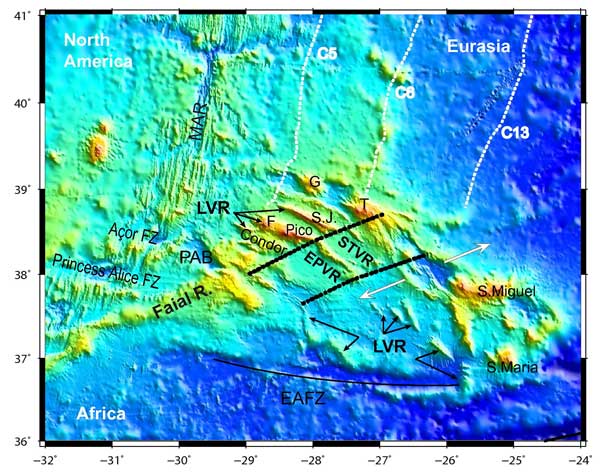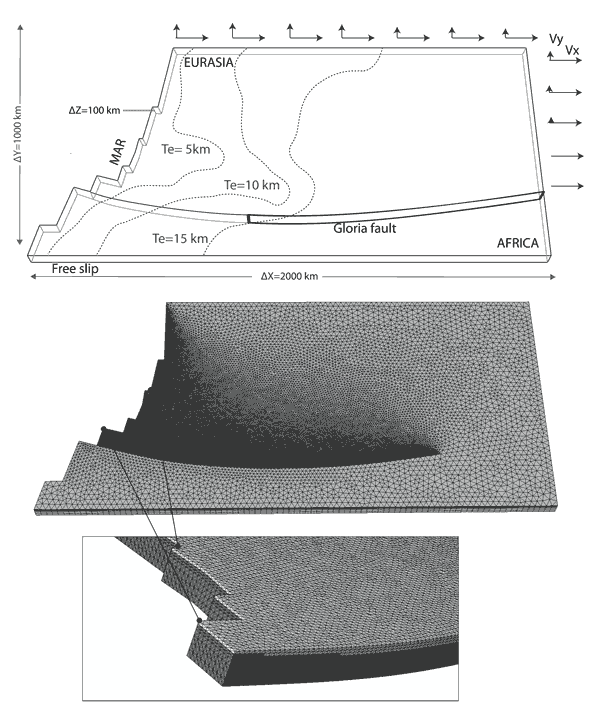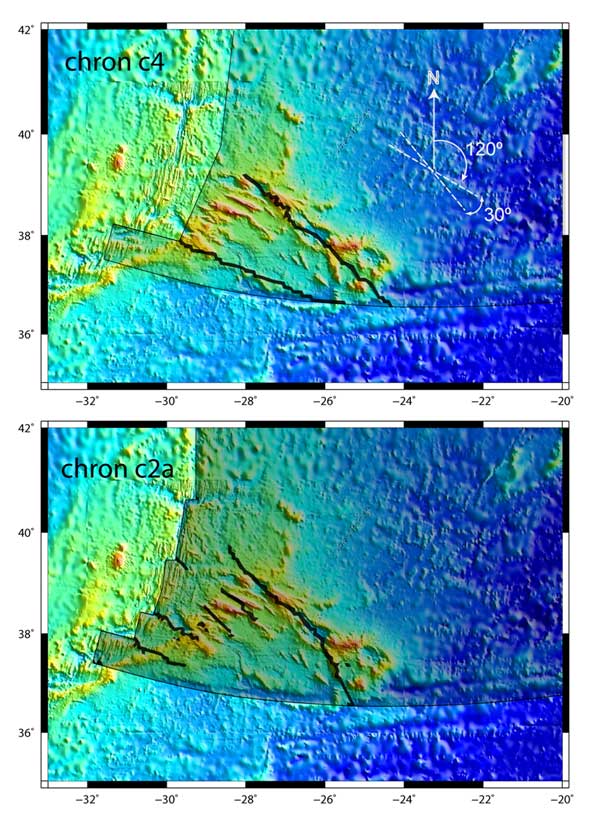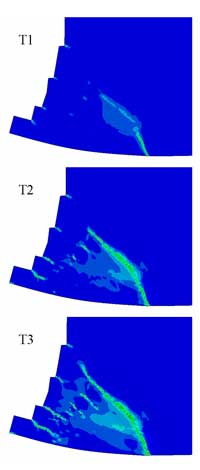 |
The Azores: Lithospheric processes & linear volcanic ridges |
Maria C. Neves1, Jorge M. Miranda2, & Joaquim F. Luis1
1Universidade do Algarve, FCT, ED8, Campus de Gambelas, 8005 139 Faro, Portugal; mcneves@ualg.pt ; jluis@ualg.pt
2Instituto Português do Mar e da Atmosfera, IDL, Rua C do Aeroporto de Lisboa, 1749 077 Lisboa, Portugal; jmmiranda@fc.ul.pt
This webpage is a summary of: Neves, M.C., J.M. Miranda, J.F. Luis, The role of lithospheric processes on the development of linear volcanic ridges in the Azores, Tectonophysics, 608, 376-388, 2013.
Linear volcanic ridges (LVRs) are widespread along the Azores plateau and are often used as tectonic markers of the surface stress field (Figure 1). Nevertheless, the mechanisms that drive the emplacement and development of these structures are not well established. They have been attributed variously to plateau diffuse deformation, off-rift extension, and interaction between a hotspot and the brittle lithosphere. In this webpage we hypothesize that LVRs are the result of magma emplacement into pre-existing damaged lithosphere.

Figure 1: The Azores plateau. plotted on a 250-m bathymetric grid. Linear Volcanic Ridge sectors are separated by black dotted lines. LVR: Linear Volcanic Ridges, EPVR: East Pico Volcanic Ridge, STVR: South Terceira Volcanic Ridge, Faial R.: Faial Ridge, F: Faial Island, G: Graciosa Island, S.J.: St. Jorge Island, T: Terceira Island, PAB: Princess Alice Basin, EAFZ: East Azores Fracture Zone, MAR: Mid-Atlantic Ridge. White dotted lines indicate isochrons c5 (~10.3 Ma), c6 (~19.6 Ma) and c13 (~33.3 Ma). White vectors between Terceira and S. Miguel islands indicate the relative motion between Eurasia and Africa at the time of Chron c4.
We use a three-dimensional finite-element representation of the brittle lithosphere and underlying ductile mantle, and assume that the deformation is driven by plate boundary forces applied at the edges, as described by global plate kinematic models. The brittle layer is assigned an elastoplastic rheology with progressive damage, and fractures are assumed to be analogous to localized shear bands. The ductile mantle beneath is modeled as a viscoelastic layer that exerts a shear drag on the base of the brittle layer. Modeling is done using a commercial finite-element program (ABAQUS/Explicit) that uses the explicit forward Euler algorithm and a large-displacement formulation.
Initially we build on two-dimensional models that demonstrate the modeling principles and illustrate our two main premises:
- shearing in the Azores can drive a curved crack resembling the Terceira Rift, and
- variations in brittle thickness enhance damage and help to localize fractures and LVRs.
We then develop three-dimensional models that integrate a velocity discontinuity at the EAFZ/Gloria fault intersection and brittle thickness variations (Figure 2). They represent two initially undamaged scenarios. The first is based on plate reconstructions at the time of Chron c4 (~7.56 Ma) when it is presumed that fracturing leading to LVR formation began. The second incorporates present-day MAR segmentation and represents the tectonic setting in the last 3 Ma, subsequent to ~ Chron c2a (~3.06 Ma).

Figure 2: Three-dimensional finite element model and mesh. The model contains an upper brittle layer and a lower ductile layer discretized into an irregular mesh with a minimum element length of 5 km. The close-up shows the grid in the SW corner of Eurasia. The base of the brittle layer, defined by the elastic plate thickness (Te), varies between 5 and 15 km. Eurasia and Africa interact along the Gloria fault, defined as a contact surface. Velocity boundary conditions consistent with a fixed African plate are indicated by black arrows. Free slip boundary conditions apply at the lateral sides of Africa and at the bottom of the model.
The modeling shows that kinematics and plate geometry alone can account for breaking the upper brittle lithosphere in the Azores during the last 10 Ma (Figure 3). Models of the tectonic situation at Chron c4 reproduce the N120° and N150° trends that are consistent with initial rifting directions. The inception of the Terceira Rift may be explained by failure of the upper plate along a crack that starts at the Gloria fault limit. At Chron c2a the predicted fractures match particularly well the orientation of the LVRs in the second (~N135°–N140°) and third (N150° to N–S) sectors and explain the arcuate shape of the Terceira Rift.

Figure 3: Model results. The predicted damage (black elements) is superimposed on the Azores bathymetry to highlight comparison between fracturing and LVRs. The chron c4 model has constant brittle plate thickness (Te=10 km) and the chron c2a model has variable Te (as depicted in Figure 2). Plate geometry, brittle thickness variations and boundary conditions control the individual trends of the predicted damage zones.
Mantle drag on the base of the brittle plate is crucial for the development of the more recent LVRs. The timing of predicted fracturing depends on model parameters. For LVR widths of ~10 km the fracture network takes 1 - 6 Ma to develop, for the highest mantle viscosities of 5x1021 - 5x1022 Pa s. In the best-fit model, with a top mantle viscosity of 1x1022 Pa s, the fracture network takes ~3 Ma to develop (Figure 4). This is consistent with age determinations in the Azores indicating that the LVRs are younger than ~2 Ma.

Figure 4: Evolution of the fracture pattern for the Chron c2a setup. Green indicates full degradation or damage. As the present day tectonic activity concentrates in the first LVR sector (comprising S. Jorge, Faial and Pico islands) we favor a model in which the initiation of the Terceira Rift (at time T1) is followed by the creation (at time T2) and latter growth (at time T3) of the Faial Ridge structures. For an LVR width of ~10 km and top mantle viscosity of ~1x1022 Pa s the timing is T1=~1 Ma, T2=~2 Ma and T3=~3 Ma.
The present tectonic configuration favors the creation of fractures along the Faial Ridge which, according to the results, post-date the Terceira Rift. These fractures grow with time but do not reach the MAR. The results are thus in agreement with the present day concentration of tectonic activity in the first LVR sector, comprising Faial, Pico and S. Jorge islands, and with the existing gap at the triple junction region.
Bibliography
-
Adam, C., Madureira, P.,Miranda, J.M., Lourenço, N., Yoshida, M., Fitzenz, D., 2013.Mantle dynamics and characteristics of the Azores Plateau. Earth Planet. Sci. Lett. http://dx.doi.org/10.1016/j.epsl.2012.11.014.
-
Beier, C., Haase, K., Abouchami, W., Krienitz, M.-S., Hauff, F., 2008. Magma genesis byrifting of oceanic lithosphere above anomalous mantle: Terceira Rift, Azores. Geochem. Geophys. Geosyst. 9, Q12013. http://dx.doi.org/10.1029/2008GC002112.
-
Cannat, M., Briais, A., Deplus, C., Escartín, J., Georgen, J., Lin, J., Mercouriev, S., Meyzen, C., Muller, M., Pouliquen, G., Rabain, A., Silva, P., 1999. Mid-Atlantic Ridge–Azores hotspot interactions: along-axis migration of a hotspot-derived event of enhanced magmatism 10 to 40 Ma ago. Earth Planet. Sci. Lett. 173, 257–269.
-
Georgen, J.E., Sankar, R.D., 2010. Effects of ridge geometry on mantle dynamics in an oceanic triple junction region: implications for the Azores Plateau. Earth Planet. Sci. Lett. 298, 23–34.
-
Goslin, J., Benoit, M., Blanchard, D., Bohn, M., Dosso, L., Dreher, S., Etoubleau, J., Gente, P., Gloaguen, R., Imazu, Y., Luis, J., Maia, M.,Merkouriev, S., Oldra, J.-P., Patriat, P., Ravilly, M., Souriot, T., Thirot, J.-L., Yamaashi, T., 1999. Extent of Azores plume influence on the Mid-Atlantic Ridge north of the hotspot. Geology 27, 991–994.
-
Guest, J.E., Gaspar, J.L., Cole, P.D., Queiroz, G., Duncan, A.M., Wallenstein, N., Ferreira, T., Pacheco, J.-M., 1999. Volcanic geology of Furnas Volcano, São Miguel, Azores. J. Volcanol. Geotherm. Res. 92, 1–29.
-
Johnson, C.L., Wijbrans, J.R., Constable, C.G., Gee, J., Staudigel, H., Tauxe, L., Forjaz, V.H., Salgueiro, M., 1998. 40Ar/39Ar ages and paleomagnetism of São Miguel lavas, Azores. Earth Planet. Sci. Lett. 160, 637–649.
-
Lemaitre, J., 1992. A Course on Damage Mechanics, 2nd ed. Springer Verlag, New York (262 pp.).
-
Lourenço, N., Miranda, J.M., Luis, J.F., Ribeiro, A., Mendes-Victor, L.A.,Madeira, J., Needham, H.D., 1998. Morpho-tectonic analysis of the Azores Volcanic Plateau from a new bathymetric compilation of the area. Mar. Geophys. Res. 20, 141–156.
-
Luis, J.F., Miranda, J.M., 2008. Re-evaluation of magnetic chrons in the North-Atlantic between 35 N and 47 N: implications for the formation of the Azores triple junction and associated plateau. J. Geophys. Res. 113, B10105.
-
Luis, J.F., Neves, M.C., 2006. The isostatic compensation of the Azores Plateau: a 3D admittance and coherence analysis. J. Volcanol. Geotherm. Res. 156, 10–22.
-
Silveira, G., Vinnik, L., Stutzmann, E., Farra, V., Kiselev, S., Morais, I., 2010. Stratification of the Earth beneath the Azores from P and S receiver function. Earth Planet. Sci. Lett. 299, 91–103.
Stretch, R.C., Mitchell, N.C., Portaro, R.A., 2006. A morphometric analysis of the submarine volcanic ridge south-east of Pico Island, Azores. J. Volcanol. Geotherm. Res. 156, 35–54.
-
Yang, T., Shen, Y., van der Lee, S., Solomon, S.C., Hung, S., 2006. Upper mantle structure beneath the Azores hotspot from finite-frequency seismic tomography. Earth Planet. Sci. Lett. 250, 11–26.
last updated 16th
February, 2014 |
